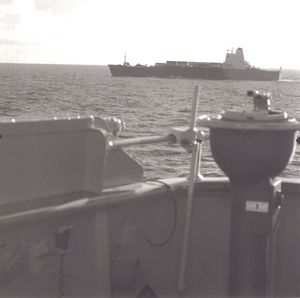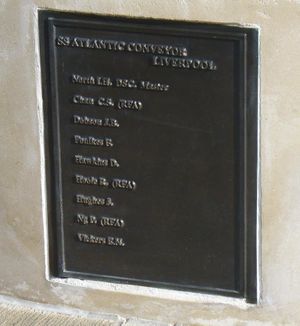MV Atlantic Conveyor
| 300px | |
| Career | |
|---|---|
| Name: | Atlantic Conveyor |
| Operator: | Cunard Line |
| Builder: | Swan Hunter |
| Completed: | 1970 |
| Identification: | IMO number: 6926036 |
| Fate: |
struck by two Exocet missiles on 25 May 1982 Burnt and subsequently abandoned Eventually sank on 30 May |
| General characteristics | |
| Class and type: | Container ship |
| Tonnage: | 14,950 tons |
| Speed: | 23 kn |
| |||||
The Atlantic Conveyor was a British merchant navy ship, registered in Liverpool, that was requisitioned during the Falklands War and sunk on 25 May 1982 after being hit by two Argentine Exocet missiles, killing 12 sailors. The wrecksite is designated under the Protection of Military Remains Act 1986.[1]
Contents
History
The Atlantic Conveyor was a 14,950 tonne roll-on, roll-off container ship owned by Cunard. She was built along with six other container ships, each named Atlantic and flown under different national flags for different companies.
Along with her sister ship, Atlantic Causeway, the Atlantic Conveyor was requisitioned by the Ministry of Defence at the beginning of the Falklands War through the STUFT system (Ships Taken Up From Trade). Due to the short timescales, the decision that the ship was not "a high-value unit" and a controversy over whether arming auxiliaries was legal, Atlantic Conveyor was not fitted with either an active, or passive defence system.[2] The ships were used to carry supplies for the Task Force sent by the British government to retake the Falkland Islands from Argentine occupation. Sailing for Ascension Island on 25 April 1982, Atlantic Conveyor carried a cargo of six Wessex helicopters from 848 Naval Air Squadron and five RAF HC.1 Chinooks from No. 18 Squadron RAF. At Ascension, she picked up eight Fleet Air Arm Sea Harriers (809 Squadron) and six RAF Harrier GR.3 jump jets. One Chinook of B flight No. 18 Squadron RAF left the Atlantic Conveyor to support operations on Ascension. With its aircraft stored she then set sail for the South Atlantic. On arrival off the Falklands in mid-May, the Harriers were off-loaded to the carriers; the GR.3s going to HMS Hermes while the Sea Harriers were divided amongst the existing squadrons on Hermes and HMS Invincible.
On 25 May 1982 the Atlantic Conveyor was hit by two[2] Exocet missiles fired by a pair of Argentine Super Étendard jet fighter. The ship caught fire, the fire then became uncontrollable. When the fire had burnt out, the ship was boarded but nothing was recoverable and so the decision was made to sink her. The warhead exploded after penetrating the ships hull to where trucks and fuel were stored resulting in an uncontrollable fire.[3] All the helicopters but one Chinook, callsign Bravo November airborne at the time, were destroyed in the fire. The loss of these helicopters meant that British troops had to march across the Falklands to capture Stanley.
Twelve men died upon the Atlantic Conveyor, including the vessel's commander, Captain Ian North, who was posthumously awarded the Distinguished Service Cross (DSC). The ship was the first British merchant vessel lost at sea to enemy fire since World War II.
The ship's replacement was built on Tyneside.
Piloting a Sea King helicopter of 820 Naval Air Squadron, Prince Andrew (then second in line to the throne) was first to lift off survivors.[4]
Techniques to Defeat Anti-Ship Missiles
A dangerous task, carried out by Sea Kings, was to act as decoys, to deflect sea-skimming missiles away from surface ships. This was achieved by hovering close to the ship and as the radar seeker could not resolve targets in azimuth the ship/helicopter combination appeared as a single target. If the helicopter was not too high the missile guidance system would aim for the centroid of its apparent target and hopefully pass between the two. HRH Prince Andrew at one point flew his helicopter as an Exocet missile decoy[5]. Chaff rockets aim to seduce a missile with a similar technique by increasing the apparent length of the target[6]. It is often suggested that cost savings prevented the fitting of chaff rockets to Atlantic Conveyor and that this could have saved the ship. However, the size of the ship's radar cross section (RCS) was too great to allow chaff decoys to be effective and their employment would have been unlikely to have affected the outcome.[7] It has also been claimed—incorrectly—that the ship acted as a decoy against a subsequent Exocet attack.[8]
Deaths
The 12 men killed in the sinking of the Atlantic Conveyor were:
- Bosun John B. Dobson
- Mechanic Frank Foulkes
- Steward David R. S. Hawkins
- Mechanic James Hughes
- Captain Ian H. North, DSC
- Mechanic Ernest M. Vickers
- 1st Radio Officer Ronald Hoole
- Seaman Ng Por
- Seaman Chan Chi Shing
- Chief Petty Officer Edmund Flanagan
- Air Engineering Mechanic (R) Adrian J. Anslow
- Leading Air Engineering Mechanic (L) Don L. Price
As the last resting place of the remains of those who died, the wreck is designated as a protected place under the Protection of Military Remains Act 1986.
Cultural references
- Pink Floyd's 1983 album, "The Final Cut," included an excerpt from a news broadcast about the replacement of the Atlantic Conveyor in track 1, "The Post-war Dream"
Further reading
- Charles Drought - N. P. 1840 The Loss of the Atlantic Conveyor (2003) ISBN 1-901231-41-0
- Board of Inquiry into the Loss of SS Atlantic Conveyor
Notes and references
- ↑ Designation under the Protection of Military Remains Act 1986 by SI2008/950, Office of Public Sector Information, The National Archives. Retrieved 2008-07-17.
- ↑ 2.0 2.1 Evans, Michael (2007-12-11). "Legal fears left Atlantic Conveyor defenceless". The Times (London). http://www.timesonline.co.uk/tol/news/uk/article3031542.ece.
- ↑ Chant, Christopher (2001). Air War in the Falklands 1982. Oxford: Osprey Publishing. pp. 55. ISBN 1841762938.
- ↑ Taylor, Robert. "Sea King Rescue, signed by Prince Andrew". http://www.naval-art.com/tankers,_cargo_ships.htm.
- ↑ "Flypast brings curtain down on Falklands commemorative events". June 2007. http://www.mod.uk/DefenceInternet/DefenceNews/HistoryAndHonour/FlypastBringsCurtainDownOnFalklandsCommemorativeEventsvideo.htm.
- ↑ "The Helicopter Museum". http://www.hmfriends.org.uk/falklands25th.htm.
- ↑ Target Detection by Marine Radar, John N Briggs, IEE
- ↑ Insight Team Sunday Times (1982). War in the Falklands: the Full Story. The Sunday Times. ISBN 0060150823.
Coordinates: 50°40′S 54°28′W / 50.667°S 54.467°W
de:Atlantic Conveyor fr:Atlantic Conveyor it:Atlantic Conveyor lt:Atlantic Conveyor nl:Atlantic Conveyor pl:Atlantic Conveyor


